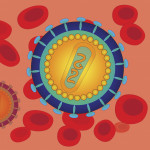Research published last week in the AAAS’s Science Translational Medicine imprint reported that the SARS-CoV-2 virus can chronically persist in the gut for over 2 years.
The findings, published by the UCSF team that brought us in 2012 what at first appeared to be a BMT AIDS cure, also documented T cell immune activation across the bodies and brains of people after COVID. The T cell activation was particularly elevated in the spinal cord and gut wall of participants with long COVID.
read free access bits of the paper here
read full text of an equally fascinating paper from 2023 (different research team), “Viral persistence, reactivation, and mechanisms of long COVID,” here
“Long COVID is not a mystery,” argued Michael Peluso MD, an ID researcher at the UCSF School of Medicine and lead author on the paper. “Our findings provide clear evidence of virus persistence and sustained immune activation after COVID-19.”
Tens of millions of people across the globe are sick with long COVID, often suffering debilitating chronic symptoms that can last for years. The new study findings provide compelling evidence for two potential causes of long COVID: persistent SARS-CoV-2 infection and aberrant T cell activation.
The findings provide compelling evidence for two potential causes of long COVID: persistent infection and aberrant T cell activation."
More specifically, the team used an advanced imaging method called whole-body positron emission tomography (aka whole-body PET) with a special tracer injected intravenously to map activated T cells throughout the bodies of the 24 study participants from 27 to 910 days following COVID infection.
Post-COVID study participants showed increased T cell activation in sites across the brain and body, including the brain stem, bone marrow, cardiac tissues, and the gut wall compared to people who were never infected with the virus.
Because the gut was a prime site of T cell activation in participants with long COVID, the scientists analyzed gut tissue obtained from a subset of patients. In these samples, they identified the presence of SARS-CoV-2 RNA up to 676 days following initial COVID onset. Viral RNA was detected in samples from all five long COVID patients tested. The chronic viral RNA was discovered in connective tissue of the gut wall (most likely the serosa), a site rich in immune cells. This suggests the persistent virus may be prompting an immune response, potentially driving long COVID symptoms.
Some gut samples showed strong evidence of active viral presence. “We found SARS-CoV-2 double-stranded RNA in 3 long COVID gut samples,” says UCSF’s Tim Henrich MD, who co-led the study. “This double-stranded RNA is usually produced during viral replication or active viral life cycling.”
The UCSF team will next pilot a trial of a monoclonal antibody against Sars-Cov-2, with one study currently enrolling (see ClinTrials overview here).
read about the AERO1 and AERO2 mAbs in a Jan 2024 ID paper here
Mike Barr, a longtime Poz Contributing Editor and founding member of and scribe for the Treatment Action Group (TAG), is a functional medicine practitioner and herbalist in NYC, NJ and PA. Reach out to him here. Or sign up for his curated (& heavily discounted) professional grade supplement dispensary here.







